So, you’ve decided to add a patio to your home. Sounds exciting, right? A space for morning coffee, summer barbecues, or just somewhere to stretch out and breathe fresh air without leaving your property. Unfortunately, many homeowners underestimate just how tricky a patio project can be. You may have typed “patio installation atlanta” into Google because you want a local pro to step in. Either way, the truth is this—patios aren’t as simple as laying down some stones and calling it a day.

If you’re not careful, you could end up spending a lot of money on something that looks great at first but becomes a constant headache later. And really, who wants that? This article discusses three installation mistakes you want to avoid.
1: Ignoring Drainage
Rainwater might not sound like a big deal, but if you don’t have proper drainage, your beautiful patio can quickly become a swampy mess.
The problem usually starts when homeowners forget that the patio isn’t just about looks. It’s a functional outdoor structure that needs to work with the natural flow of water around your home. If it’s built without the right slope—or worse, if it slopes toward your house—you’re in for trouble. Water can pool against your foundation, leading to erosion, leaks, and even basement flooding.
Here’s the thing: you don’t have to be an expert to understand the basics. A good patio should slope away from your home at about a quarter inch per foot. That small adjustment makes all the difference. If you’re hiring someone, ask them about their drainage plan. If they can’t explain it clearly, that’s a red flag.
2: Skipping a Solid Base
A patio isn’t like throwing a rug on the lawn. It needs a solid foundation. And yet, one of the most common mistakes is skimping on the base layer. Maybe someone’s eager to save a little money, or maybe they’re just impatient to see the project finished. Either way, skipping this step almost always comes back to haunt you.
Without a proper base—usually made of compacted gravel or crushed stone—your patio stones or pavers won’t stay level. Over time, they’ll shift, sink, or start popping up at odd angles. You’ve probably seen patios like this: uneven, with weeds pushing through the cracks.
To get a stable base, you need to dig down a good six to eight inches, depending on the soil and climate in your area. Then it has to be compacted in layers. Yes, it takes more effort upfront, but it’s the difference between a patio that lasts a couple of seasons and one that lasts for decades.
3: Choosing the Wrong Materials
It’s easy to get carried away when choosing patio materials. You walk into a showroom or browse online catalogs, and suddenly you’re falling in love with sleek porcelain tiles or exotic stone. They look stunning, no doubt. But are they practical for your climate and lifestyle? That’s where a lot of people go wrong.
For example, smooth tiles might look amazing, but they get slippery when wet. Do you really want to be worried about slipping every time it rains? On the flip side, some natural stones are porous and don’t handle freeze-thaw cycles very well. They start cracking and crumbling after just a couple of winters. That’s a hard lesson to learn after spending thousands on materials.
The smart move is to balance aesthetics with practicality. Think about maintenance, too. Some materials require sealing every year to prevent stains or weather damage. Others, like concrete pavers, are more forgiving and easier to replace if one gets damaged. Ask yourself what you really want: a low-maintenance space where you can just relax, or a high-maintenance one that demands constant attention?
Final Thoughts
A patio is an extension of your home that lets you enjoy the outdoors without leaving your property. But excitement shouldn’t lead to shortcuts. The truth is, most of the major patio headaches come from preventable mistakes: poor drainage, weak foundations, the wrong materials, or just not thinking big enough. Before diving into your project, ask yourself: am I rushing this, or am I planning carefully?






